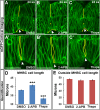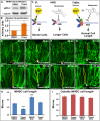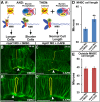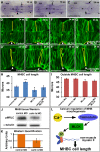Calcium signals drive cell shape changes during zebrafish midbrain-hindbrain boundary formation
- PMID: 28148652
- PMCID: PMC5385936
- DOI: 10.1091/mbc.E16-08-0561
Calcium signals drive cell shape changes during zebrafish midbrain-hindbrain boundary formation
Abstract
One of the first morphogenetic events in the vertebrate brain is the formation of the highly conserved midbrain-hindbrain boundary (MHB). Specific cell shape changes occur at the point of deepest constriction of the MHB, the midbrain-hindbrain boundary constriction (MHBC), and are critical for proper MHB formation. These cell shape changes are controlled by nonmuscle myosin II (NMII) motor proteins, which are tightly regulated via the phosphorylation of their associated myosin regulatory light chains (MRLCs). However, the upstream signaling pathways that initiate the regulation of NMII to mediate cell shape changes during MHB morphogenesis are not known. We show that intracellular calcium signals are critical for the regulation of cell shortening during initial MHB formation. We demonstrate that the MHB region is poised to respond to calcium transients that occur in the MHB at the onset of MHB morphogenesis and that calcium mediates phosphorylation of MRLC specifically in MHB tissue. Our results indicate that calmodulin 1a (calm1a), expressed specifically in the MHB, and myosin light chain kinase together mediate MHBC cell length. Our data suggest that modulation of NMII activity by calcium is critical for proper regulation of cell length to determine embryonic brain shape during development.
© 2017 Sahu, Visetsouk, et al. This article is distributed by The American Society for Cell Biology under license from the author(s). Two months after publication it is available to the public under an Attribution–Noncommercial–Share Alike 3.0 Unported Creative Commons License (http://creativecommons.org/licenses/by-nc-sa/3.0).
Figures





Similar articles
-
Midbrain-Hindbrain Boundary Morphogenesis: At the Intersection of Wnt and Fgf Signaling.Front Neuroanat. 2017 Aug 3;11:64. doi: 10.3389/fnana.2017.00064. eCollection 2017. Front Neuroanat. 2017. PMID: 28824384 Free PMC article. Review.
-
Non-muscle myosin IIA and IIB differentially regulate cell shape changes during zebrafish brain morphogenesis.Dev Biol. 2015 Jan 1;397(1):103-15. doi: 10.1016/j.ydbio.2014.10.017. Epub 2014 Oct 31. Dev Biol. 2015. PMID: 25446029
-
Zebrafish gbx1 refines the midbrain-hindbrain boundary border and mediates the Wnt8 posteriorization signal.Neural Dev. 2009 Apr 2;4:12. doi: 10.1186/1749-8104-4-12. Neural Dev. 2009. PMID: 19341460 Free PMC article.
-
Midbrain-hindbrain boundary patterning and morphogenesis are regulated by diverse grainy head-like 2-dependent pathways.Development. 2012 Feb;139(3):525-36. doi: 10.1242/dev.066522. Development. 2012. PMID: 22223680
-
Novel mechanisms that pattern and shape the midbrain-hindbrain boundary.Cell Mol Life Sci. 2013 Sep;70(18):3365-74. doi: 10.1007/s00018-012-1240-x. Epub 2013 Jan 10. Cell Mol Life Sci. 2013. PMID: 23307071 Free PMC article. Review.
Cited by
-
Calcium Signaling in Vertebrate Development and Its Role in Disease.Int J Mol Sci. 2018 Oct 30;19(11):3390. doi: 10.3390/ijms19113390. Int J Mol Sci. 2018. PMID: 30380695 Free PMC article. Review.
-
Midbrain-Hindbrain Boundary Morphogenesis: At the Intersection of Wnt and Fgf Signaling.Front Neuroanat. 2017 Aug 3;11:64. doi: 10.3389/fnana.2017.00064. eCollection 2017. Front Neuroanat. 2017. PMID: 28824384 Free PMC article. Review.
-
A simple mechanochemical model for calcium signalling in embryonic epithelial cells.J Math Biol. 2019 Jun;78(7):2059-2092. doi: 10.1007/s00285-019-01333-8. Epub 2019 Mar 2. J Math Biol. 2019. PMID: 30826846 Free PMC article.
-
CRISPR-RfxCas13d screening uncovers Bckdk as a post-translational regulator of the maternal-to-zygotic transition in teleosts.bioRxiv [Preprint]. 2024 May 23:2024.05.22.595167. doi: 10.1101/2024.05.22.595167. bioRxiv. 2024. PMID: 38826327 Free PMC article. Preprint.
-
Epithelial restitution in 3D - Revealing biomechanical and physiochemical dynamics in intestinal organoids via fs laser nanosurgery.iScience. 2023 Oct 5;26(11):108139. doi: 10.1016/j.isci.2023.108139. eCollection 2023 Nov 17. iScience. 2023. PMID: 37867948 Free PMC article.
References
-
- Ashworth R, Devogelaere B, Fabes J, Tunwell RE, Koh KR, De Smedt H, Patel S. Molecular and functional characterization of inositol trisphosphate receptors during early zebrafish development. J Biol Chem. 2007;282:13984–13993. - PubMed
-
- Barreda EG, Avila J. Tau regulates the subcellular localization of calmodulin. Biochem Biophys Res Commun. 2011;408:500–504. - PubMed
-
- Berridge MJ, Lipp P, Bootman MD. The versatility and universality of calcium signalling. Nat Rev. 2000;1:11–21. - PubMed
-
- Bootman MD, Collins TJ, Mackenzie L, Roderick HL, Berridge MJ, Peppiatt CM. 2-aminoethoxydiphenyl borate (2-APB) is a reliable blocker of store-operated Ca2+ entry but an inconsistent inhibitor of InsP3-induced Ca2+ release. FASEB J. 2002;16:1145–1150. - PubMed
-
- Bramlage P, Joss G, Staudt A, Jarrin A, Podlowski S, Baumann G, Stangl K, Felix SB, Stangl V. Computer-aided measurement of cell shortening and calcium transients in adult cardiac myocytes. Biotechnol Prog. 2001;17:929–934. - PubMed
MeSH terms
Substances
LinkOut - more resources
Full Text Sources
Other Literature Sources
Molecular Biology Databases

